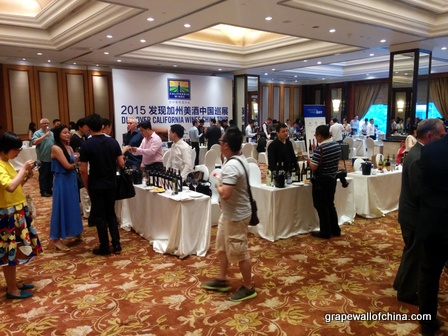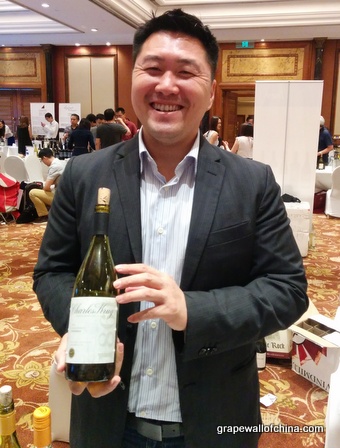
My experience with U.S. regional wine promotions in China has not been great during the past decade or so. Yes, I have managed to get on the radar for some events, including a few good ones, but I have often wondered what it takes to remain a blip.
A California Wine Institute (CWI) tasting earlier this month in Beijing is a good example. I only knew about the event due to Alex Chen, of U.S. wine importer and distributor Alexander Wines in Shanghai, a single contact that apparently gave me greater guanxi than many other people. This was evident when I showed up to a hotel event room full of tasty wines but few tasters. It was also evident when I posted about it to Facebook and Weixin and found, especially on the latter platform, trade people who had no idea about the event and, in a few cases, were critical of past ones as well.
In case you think I’m alone in wondering about U.S. strategies, consider this report by the USDA Foreign Agricultural Service two years ago. It’s called “South China Hidden Treasures Report“, focuses on cities beyond the so-called “first tier”, and verges on pleading for visits to them. Here is the report’s conclusion (my highlights):
China represents the single largest growth prospect for wine producing countries around the world. Besides targeting mature markets in South China especially within the Pearl River Delta’s major hubs like Guangzhou and Shenzhen, secondary cities with flourishing economic booms and strong purchasing power are already attracting more wineries. A continued interest in U.S. wines has proven a prosperous business endeavor for many exporters that have heeded ATO Guangzhou’s advice. The outlook in South China’s emerging 2nd tier cities remains positive and it is crucial [for] American regional wine associations to take the initiative and challenge competitors like France, Australia, Chile, South Africa and Italy, [whose associations] have already visited those cities. South China’s 2nd and 3rd tier cities do not rely on suppliers from Beijing or Shanghai. Wine exporters visiting Shanghai will discover that there are few distributors there that have access and distribution channels in the Pearl River Delta or in Hunan or Fujian Provinces for that matter. The Napa Valley Vintners has made about eight visits to Mainland China and has yet to visit any cities in South China since the organization was formed. ATO Guangzhou is calling all U.S. producer associations and exporters to keep official trade statistics present when deciding where to plan tastings. Including 2nd tier cities will open new paths to sales channels that will grow at a faster pace than in any 1st tier city market. Let ATO Guangzhou show you the way!
I cite this report because its macro outlook and my experience represent two points on a continuum of concern about how the U.S. wine trade handles promotion in China.
That brings me back to the CWI event this month and, particularly, what happened right after it. Alex Chen put me in touch with Chris Beros, the China director of California Wine Institute, who knew about my posts on social media. Beros then called to explain he was fairly new to the job and CWI had some intriguing projects in the pipeline. Even more, he then took time to meet me in Beijing yesterday so I could get details. Admittedly, I found all this interaction a bit shocking!
Anyway, along with plans to better promote California wine, including via this social media position, Beros says there will be a series of master classes slated over the coming year in 21 cities beyond the usual suspects of Beijing and Shanghai (see the full schedule below).
He said CWI also decided to forgo the typical strategy of outsourcing classes to educators and instead hired Paul Hu as its official trainer. That will likely be cost-efficient and, with in-house course materials, result in consistency across classes, some of which will paired with tastings aimed at general consumers.
Will this new project face many challenges? Undoubtedly, given CWI lacks experience in most, if not all, of the cities on the proposed tour.
Is it worth that risk? Undoubtedly, unless you think having U.S. wine reps involved in more events like the one in Beijing this month is a better use of money.
California has a lot of ways to reach out to Chinese consumers. Consider just one: the thousands upon thousands of Chinese who have graduated from college in that state and are now spread across this country. I suspect it would be profitable to get involved with their alumni associations, and especially their weixin groups, where every member is a potential California wine ambassador.
It’s exciting to see a program like this–not to mention surprising that someone at CWI actually cares what a blogger thinks!–and hopefully it means more people in China will try U.S. wines.
Here is the proposed schedule for the tour, which is scheduled to kick off in just three weeks. I’ll post again when I have more details.
Week of 20 July 2015
- Dalian, Yantai and Qingdao
Week of 17 August 2015
- Shenyang, Changchun and Harbin
Week of 14 September 2015
- Tianjin, Jinan and Hefei
Week of 12 October 2015
- Kunming, Guiyang and Nanning
Week of 30 November 2015
- Fuzhou, Quanzhou and Xiamen
Week of 01 March 2016
- Guangzhou, Shenzhen and Haikou
Week of 18 April 2016
- Xi’an, Taiyuan and Chongqing

Grape Wall has no sponsors of advertisers: if you find the content and projects like World Marselan Day worthwhile, please help cover the costs via PayPal, WeChat or Alipay.
Sign up for the free Grape Wall newsletter here. Follow Grape Wall on LinkedIn, Instagram, Facebook and Twitter. And contact Grape Wall via grapewallofchina (at) gmail.com.

Hi Jim, very interesting as we, at CWS, were also not aware about this tasting + those trainings around 2nd & 3rd cities….